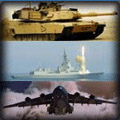Guerra de Afganistán
Moderadores: Lepanto, poliorcetes, Edu, Orel
Re: Guerra de Afganistán
Galería de fotos de nuestros helos en Astán (incluyendo varias con Tigres, así que son recientes):
http://www.abc.es//fotos-abc/20130509/h ... elemento=1
http://www.abc.es//fotos-abc/20130509/h ... elemento=1
Escucha también el Podcast:
https://www.youtube.com/channel/UCuBzQorV74eTFq8HlK7-zRA
https://www.ivoox.com/podcast-portierramaryaire-podcast_sq_f1456223_1.html
Y tenemos un Patreon:
https://www.patreon.com/portierramaryaire
https://www.youtube.com/channel/UCuBzQorV74eTFq8HlK7-zRA
https://www.ivoox.com/podcast-portierramaryaire-podcast_sq_f1456223_1.html
Y tenemos un Patreon:
https://www.patreon.com/portierramaryaire
-

Orel - Moderador
- Mensajes: 46184
- Registrado: Sab Sep 24, 2005 11:33 am
- Ubicación: España, en el bocho
Re: Guerra de Afganistán
los ingleses están bajo el fuego de cohetes iraníes


"las victorias tienen más de cien padres, pero las derrotas son siempre huérfanas"
-

Roger - Mensajes: 3376
- Registrado: Jue Ago 11, 2005 6:55 pm
- Ubicación: Bailando en la disco con Milla Jovovich
Re: Guerra de Afganistán
La historia se repite, unos invaden Afganistán y otros arman a los que se resisten a la invasión.
Saludos.
Saludos.
...que parezca un accidente...
-

ruso - Mensajes: 8085
- Registrado: Lun Jul 28, 2008 6:58 pm
Re: Guerra de Afganistán
Vuelo nocturno HELISAF (26 marzo 2013):
http://www.abc.es/videos-internacional/ ... 54001.html
http://www.abc.es/videos-internacional/ ... 54001.html
Escucha también el Podcast:
https://www.youtube.com/channel/UCuBzQorV74eTFq8HlK7-zRA
https://www.ivoox.com/podcast-portierramaryaire-podcast_sq_f1456223_1.html
Y tenemos un Patreon:
https://www.patreon.com/portierramaryaire
https://www.youtube.com/channel/UCuBzQorV74eTFq8HlK7-zRA
https://www.ivoox.com/podcast-portierramaryaire-podcast_sq_f1456223_1.html
Y tenemos un Patreon:
https://www.patreon.com/portierramaryaire
-

Orel - Moderador
- Mensajes: 46184
- Registrado: Sab Sep 24, 2005 11:33 am
- Ubicación: España, en el bocho
Re: Guerra de Afganistán
Galería de la Guardia Civil en Afganistán (52 agentes desplegados): http://www.abc.es/fotos-abc/20130522/en ... 20921.html
No sabía que contaban con armas tan pesadas como ametralladoras de 12,70 mm.
No sabía que contaban con armas tan pesadas como ametralladoras de 12,70 mm.
Escucha también el Podcast:
https://www.youtube.com/channel/UCuBzQorV74eTFq8HlK7-zRA
https://www.ivoox.com/podcast-portierramaryaire-podcast_sq_f1456223_1.html
Y tenemos un Patreon:
https://www.patreon.com/portierramaryaire
https://www.youtube.com/channel/UCuBzQorV74eTFq8HlK7-zRA
https://www.ivoox.com/podcast-portierramaryaire-podcast_sq_f1456223_1.html
Y tenemos un Patreon:
https://www.patreon.com/portierramaryaire
-

Orel - Moderador
- Mensajes: 46184
- Registrado: Sab Sep 24, 2005 11:33 am
- Ubicación: España, en el bocho
Re: Guerra de Afganistán
Galería de fotos de material español en la base de Herat: http://www.libertaddigital.com/fotos/ma ... a-1005662/
Escucha también el Podcast:
https://www.youtube.com/channel/UCuBzQorV74eTFq8HlK7-zRA
https://www.ivoox.com/podcast-portierramaryaire-podcast_sq_f1456223_1.html
Y tenemos un Patreon:
https://www.patreon.com/portierramaryaire
https://www.youtube.com/channel/UCuBzQorV74eTFq8HlK7-zRA
https://www.ivoox.com/podcast-portierramaryaire-podcast_sq_f1456223_1.html
Y tenemos un Patreon:
https://www.patreon.com/portierramaryaire
-

Orel - Moderador
- Mensajes: 46184
- Registrado: Sab Sep 24, 2005 11:33 am
- Ubicación: España, en el bocho
Re: Guerra de Afganistán
Más fotos en Astán: http://politica.elpais.com/politica/201 ... 1370014204
Me gustan la de la línea de Rg-31 y la del lanzamiento del UAV Raven.
Me llama la atención en la que el soldado que da el alto a una moto lleva un lanzacohetes C-90 a la espalda. Es raro ¿no? Más si es un control normal.
Me gustan la de la línea de Rg-31 y la del lanzamiento del UAV Raven.
Me llama la atención en la que el soldado que da el alto a una moto lleva un lanzacohetes C-90 a la espalda. Es raro ¿no? Más si es un control normal.
Escucha también el Podcast:
https://www.youtube.com/channel/UCuBzQorV74eTFq8HlK7-zRA
https://www.ivoox.com/podcast-portierramaryaire-podcast_sq_f1456223_1.html
Y tenemos un Patreon:
https://www.patreon.com/portierramaryaire
https://www.youtube.com/channel/UCuBzQorV74eTFq8HlK7-zRA
https://www.ivoox.com/podcast-portierramaryaire-podcast_sq_f1456223_1.html
Y tenemos un Patreon:
https://www.patreon.com/portierramaryaire
-

Orel - Moderador
- Mensajes: 46184
- Registrado: Sab Sep 24, 2005 11:33 am
- Ubicación: España, en el bocho
Re: Guerra de Afganistán
De la sexta foto:
"Un soldado inspecciona el camino en busca de un posible IED (dispositivo electrónico inteligente) durante una patrulla por la Ruta Lithium."
Yo pensando que buscaban explosivos (Artefecto Explosivo Improvisado) y lo que buscan es el smartphone que debe haber perdido alguno de los jefes...


"Un soldado inspecciona el camino en busca de un posible IED (dispositivo electrónico inteligente) durante una patrulla por la Ruta Lithium."
Yo pensando que buscaban explosivos (Artefecto Explosivo Improvisado) y lo que buscan es el smartphone que debe haber perdido alguno de los jefes...



¿Gran guerrero, dices? La guerra no le hace a uno grandioso (Yoda)
-

Edu - Moderador
- Mensajes: 3884
- Registrado: Lun Ago 06, 2007 10:05 pm
- Ubicación: Madrid, a veces
Re: Guerra de Afganistán
Un par de datos sobre la retirada de EEUU de Astán que me han sorprendido. Viene del número de mayo de la revista del EdA, que trae un artículo extenso sobre la pesadilla logística que plantea la retirada de Astán:
http://www.ejercitodelaire.mde.es/stweb ... 33C698.pdf
Y de RU:
http://www.ejercitodelaire.mde.es/stweb ... 33C698.pdf
El departamento de Defensa estadounidense estima que tiene en Afganistán 36.000 millones de dólares en equipos y material
...
Estados Unidos dejará vehículos, repuestos, material y equipos valorados en 6.000 millones de dólares
Son todos aquellos considerados como no vitales, obsoletos, fuera de precio de mercado o cuyo transporte cuesta más que el propio objeto transportado. Parte serán donados a las fuerzas de seguridad afganas para que continúen la lucha contra los talibanes y aseguren la estabilidad del país.
Muchos serán destruidos para que nadie saque un último uso de ellos. Lo que no se dejará en territorio afgano son las armas pesadas, las antiaéreas o el denominado “material sensible”, como los equipos de mando y control. De este modo se quiere evitar lo que sucedió tras la retirada soviética en 1989, cuando en el país se quedaron decenas de carros de combate, misiles antiaéreos, etc. Todo un moderno y poderoso arsenal que nadie quiere ver ahora en manos de los talibanes.
...
Por ello los logistas estadounidenses trabajan duro para sacar del país cerca de 100.000 contenedores y 50.000 vehículos, entre ellos 14.000 MRAPs (Mine Resistant Ambush Protected). Esta operación, cuyo coste estará entre los 5.000 y 6.000 millones de dólares, deberá estar finalizada antes de 2014.
Y de RU:
El Reino Unido, la segunda nación en importancia por tamaño de fuerzas en Afganistán, ha estimado que tiene en el país equipamiento militar por valor de 4.000 millones de libras esterlinas, incluyendo cerca de 3.000 vehículos blindados y unos 11.000 contenedores.
Escucha también el Podcast:
https://www.youtube.com/channel/UCuBzQorV74eTFq8HlK7-zRA
https://www.ivoox.com/podcast-portierramaryaire-podcast_sq_f1456223_1.html
Y tenemos un Patreon:
https://www.patreon.com/portierramaryaire
https://www.youtube.com/channel/UCuBzQorV74eTFq8HlK7-zRA
https://www.ivoox.com/podcast-portierramaryaire-podcast_sq_f1456223_1.html
Y tenemos un Patreon:
https://www.patreon.com/portierramaryaire
-

Orel - Moderador
- Mensajes: 46184
- Registrado: Sab Sep 24, 2005 11:33 am
- Ubicación: España, en el bocho
Re: Guerra de Afganistán
5 JUN 2013
España retirará este año hasta el 70% del contingente total que llegó a tener en Afganistán (1.200 militares), y no el 50% como hasta ahora estaba oficialmente previsto, según ha anunciado en Bruselas el ministro de Defensa, Pedro Morenés.
A final de año solo quedarán en Afganistán entre 200 y 300 militares españoles en Herat, frente a los 863 que quedan ahora, “si las cosas van como están yendo, es decir, bien”, ha precisado el ministro.
http://politica.elpais.com/politica/201 ... 03737.html
Escucha también el Podcast:
https://www.youtube.com/channel/UCuBzQorV74eTFq8HlK7-zRA
https://www.ivoox.com/podcast-portierramaryaire-podcast_sq_f1456223_1.html
Y tenemos un Patreon:
https://www.patreon.com/portierramaryaire
https://www.youtube.com/channel/UCuBzQorV74eTFq8HlK7-zRA
https://www.ivoox.com/podcast-portierramaryaire-podcast_sq_f1456223_1.html
Y tenemos un Patreon:
https://www.patreon.com/portierramaryaire
-

Orel - Moderador
- Mensajes: 46184
- Registrado: Sab Sep 24, 2005 11:33 am
- Ubicación: España, en el bocho
Re: Guerra de Afganistán
Defensa concede nueve Cruces Rojas por acciones de combate en Afganistán
11 de junio de 2013
http://www.ateneadigital.es/RevistaAten ... 91_ESP.asp
Escucha también el Podcast:
https://www.youtube.com/channel/UCuBzQorV74eTFq8HlK7-zRA
https://www.ivoox.com/podcast-portierramaryaire-podcast_sq_f1456223_1.html
Y tenemos un Patreon:
https://www.patreon.com/portierramaryaire
https://www.youtube.com/channel/UCuBzQorV74eTFq8HlK7-zRA
https://www.ivoox.com/podcast-portierramaryaire-podcast_sq_f1456223_1.html
Y tenemos un Patreon:
https://www.patreon.com/portierramaryaire
-

Orel - Moderador
- Mensajes: 46184
- Registrado: Sab Sep 24, 2005 11:33 am
- Ubicación: España, en el bocho
Re: Guerra de Afganistán
Saludos
EEUU tiene que abandonar las instalaciones de Manas en Kirguizistán para Julio del 2014...
http://en.rian.ru/world/20130620/181775 ... ament.html
... tras la votación en el parlamento Kirguíz.
UN SALUDO
EEUU tiene que abandonar las instalaciones de Manas en Kirguizistán para Julio del 2014...
http://en.rian.ru/world/20130620/181775 ... ament.html
... tras la votación en el parlamento Kirguíz.
UN SALUDO
- charly015
- Mensajes: 6182
- Registrado: Vie Feb 24, 2006 6:29 pm
Re: Guerra de Afganistán
Scrapping equipment key to Afghan drawdown
By Ernesto Londoño, Published: June 20
KANDAHAR AIRFIELD, Afghanistan — Facing a tight withdrawal deadline and tough terrain, the U.S. military has destroyed more than 170 million pounds worth of vehicles and other military equipment as it rushes to wind down its role in the Afghanistan war by the end of 2014.
The massive disposal effort, which U.S. military officials call unprecedented, has unfolded largely out of sight amid an ongoing debate inside the Pentagon about what to do with the heaps of equipment that won’t be returning home. Military planners have determined that they will not ship back more than $7 billion worth of equipment — about 20 percent of what the U.S. military has in Afghanistan — because it is no longer needed or would be too costly to ship back home.
That has left the Pentagon in a quandary about what to do with the items. Bequeathing a large share to the Afghan government would be challenging because of complicated rules governing equipment donations to other countries, and there is concern that Afghanistan’s fledgling forces would be unable to maintain it. Some gear may be sold or donated to allied nations, but few are likely to be able to retrieve it from the war zone.
Therefore, much of it will continue to be shredded, cut and crushed to be sold for pennies per pound on the Afghan scrap market — a process that reflects a presumptive end to an era of protracted ground wars. The destruction of tons of equipment is all but certain to raise sharp questions in Afghanistan and the United States about whether the Pentagon’s approach is fiscally responsible and whether it should find ways to leave a greater share to the Afghans.
“We’re making history doing what we’re doing here,” said Maj. Gen. Kurt J. Stein, head of the 1st Sustainment Command, who is overseeing the drawdown in Afghanistan. “This is the largest retrograde mission in history.”
The most contentious and closely watched part of the effort involves the disposal of Mine-Resistant Ambush Protected vehicles, the hulking beige personnel carriers that the Pentagon raced to build starting in 2007 to counter the threat of roadside bombs in Iraq and Afghanistan. The massive trucks, known as MRAPs, came to symbolize the bloody evolution of wars that were meant to be short conflicts but turned into quagmires.
The Pentagon has determined that it will no longer have use for about 12,300 of its 25,500 MRAPs scattered at bases worldwide, officials said. In Afghanistan, the military has labeled about 2,000 of its roughly 11,000 MRAPs “excess.” About 9,000 will be shipped to the United States and U.S. military bases in Kuwait and elsewhere, but the majority of the unwanted vehicles — which cost about $1 million each — will probably be shredded, officials said, because they are unlikely to find clients willing to come pick them up.
“MRAPs have served us well in the current war, but we will not need all that we bought for Iraq and Afghanistan in the future,” Alan Estevez, the assistant secretary of defense for logistics and materiel readiness, said in a statement. “It is cost prohibitive to retrograde and reset MRAPs that we do not need for the future.”
‘Gold dust’
Those MRAPs that the Pentagon has deemed unnecessary have been arriving by the dozen at scrap yards at four U.S. military bases in Afghanistan in recent months. Toiling under the searing sun last week at this vast base in southern Kandahar province, contract workers from Nepal and other countries in the region wore fireproof suits and masks as they used special blowtorches to dismantle vehicles built to withstand deadly blasts. It takes about 12 hours to tear apart each MRAP.
In another section of the scrap yard, a massive grinder gobbled slabs of steel, turning them into small scraps. The debris is packed into U.S.-owned shipping containers that also have been deemed unfit to return home.
Last month, the Kandahar yard produced 11 million pounds of scrap that was sold to Afghan contractors for a few cents per pound, said Morgan Gunn, a Defense Logistics Agency employee who runs the site. Afghans use the scrap mainly for construction and as makeshift spare parts.
“Gold dust is what they call it,” Gunn said.
Military officials have drawn little attention to the scrapping operations, mindful that the endeavor might appear wasteful in an era of contracting defense budgets and misguided at a time when Afghan troops are being killed at a record rate. But officials argue that the effort is part of a withdrawal operation that is being carried out in a fiscally responsible, carefully planned manner.
“One might ask: Why not give it to the Afghans?” Stein said as he toured the Kandahar yard. “It’s such a fast-paced operation, and most of it is trash. We don’t want to leave this in the battlefield.”
As they have debated how much excess equipment to shred or sell, officials have considered whether the defense industry would suffer if the Pentagon unloaded tons of used equipment on the market at vastly reduced prices. Additionally, Pentagon policy requires that allied nations seeking to take ownership of excess U.S. equipment travel to Afghanistan to pick it up — an onerous task that few nations are likely to take on.
When the U.S. military withdrew from Iraq, it donated much of its equipment to the Iraqis, who had access to cheap fuel, a robust defense budget and more sophisticated mechanics. The Pentagon also shipped a significant share to Afghanistan, where a troop surge was underway. But donating MRAPs to the Afghans would be more complicated and potentially counterproductive, military officials said.
“Frankly, in a lot of ways, the Afghan economy and military can’t absorb some of the things the Iraqis did,” said Lt. Gen. Raymond V. Mason, the Army deputy chief of staff for logistics. “We don’t want to give [the Afghans] a lot of equipment that they can’t handle and could compound their challenges.”
Military officials said they have spent billions of dollars equipping and building up Afghanistan’s security forces over the past decade, outfitting them with lighter tactical vehicles that are a better fit for the country’s rudimentary road networks.
A situation unlike in Iraq
The U.S. Army owns the lion’s share of the military equipment currently in Afghanistan. As of May, Mason said, $25 billion worth of equipment was deployed with Army personnel. After an analysis of needs and costs, it has decided to ship back no more than 76 percent. Transporting that much will cost $2 billion to $3 billion, the Army estimates. And repairing the gear that comes back will cost $8 billion to $9 billion.
Stein, the general overseeing the Afghanistan drawdown, headed the same process in Iraq, which turned out to be a far easier mission. For starters, the U.S. military had a relatively well-
organized system in place to hand over bases and equipment to the Iraqi government 21 / 2 years before American troops pulled out entirely. Security was more permissive. And, crucially, the U.S. military could use its large bases in next-door Kuwait as a staging ground for items driven out of Iraq.
“Kuwait was a lifesaver,” Stein said, noting that there are no neighboring U.S. bases where equipment leaving Afghanistan could be easily stored. “It’s very hard to get our stuff out of Afghanistan. In Iraq, we could drive it out to Kuwait, and it sat there for a year or two until the Army decided its disposition.”
As the U.S. military reduces its footprint in Afghanistan from 150 bases to 50 by February, Stein’s teams are ramping up their efforts, finding more efficient ways of sorting through equipment to be shipped and drawing from lessons learned in Iraq.
Until a few months ago, the military flew out the vast majority of the equipment it was sending back to the United States.
In recent months, after Pakistan, a neighbor of landlocked Afghanistan, agreed to let the U.S. military use its roads to ship materiel out through its ports, most containers that don’t include sensitive materials or weapons are being trucked out by land. Shipping through Pakistan is by no means trouble-free — and officials recognize that the route could get shut down in the event of a new spat between Islamabad and Washington.
“We continue to get delays. There’s still corruption, taxes, tariffs,” Stein said. “But our equipment is getting through.”
http://www.washingtonpost.com/world/asi ... print.html
Nunca digas que éste es mi último sendero
**
podcast de portierramaryaire
https://www.ivoox.com/podcast-portierra ... 223_1.html
y recuerda nuestro patreon para actualizar el foro y crecer
https://www.patreon.com/portierramaryaire
**
podcast de portierramaryaire
https://www.ivoox.com/podcast-portierra ... 223_1.html
y recuerda nuestro patreon para actualizar el foro y crecer
https://www.patreon.com/portierramaryaire
-

poliorcetes - Site Admin
- Mensajes: 13139
- Registrado: Vie Abr 17, 2009 11:54 am
Re: Guerra de Afganistán
Las tropas afganas se estrenan en solitario en una operación.
http://www.ejercito.mde.es/noticias/2013/06/2482.html
Saludos.
http://www.ejercito.mde.es/noticias/2013/06/2482.html
Saludos.
Cuando la Infantería acorazada avanza, tiene que temblar la tierra.
Aprisa duro lejos
Corazón Cañones Corazas
Aprisa duro lejos
Corazón Cañones Corazas
-

RIAC Nº61 - Mensajes: 581
- Registrado: Mié Abr 04, 2012 8:13 pm
Re: Guerra de Afganistán
Vídeo de evacuación sanitaria de soldado español:
http://www.youtube.com/watch?feature=pl ... nPmdSUSR3c
http://www.youtube.com/watch?feature=pl ... nPmdSUSR3c
Escucha también el Podcast:
https://www.youtube.com/channel/UCuBzQorV74eTFq8HlK7-zRA
https://www.ivoox.com/podcast-portierramaryaire-podcast_sq_f1456223_1.html
Y tenemos un Patreon:
https://www.patreon.com/portierramaryaire
https://www.youtube.com/channel/UCuBzQorV74eTFq8HlK7-zRA
https://www.ivoox.com/podcast-portierramaryaire-podcast_sq_f1456223_1.html
Y tenemos un Patreon:
https://www.patreon.com/portierramaryaire
-

Orel - Moderador
- Mensajes: 46184
- Registrado: Sab Sep 24, 2005 11:33 am
- Ubicación: España, en el bocho
¿Quién está conectado?
Usuarios navegando por este Foro: No hay usuarios registrados visitando el Foro y 12 invitados
